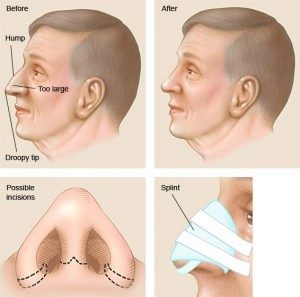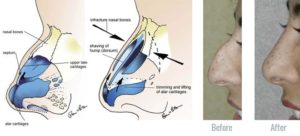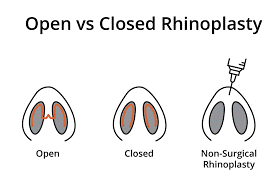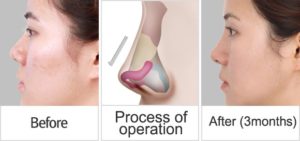What is Rhinoplasty ?
The shape of your nose plays a major role in the appearance of your face. A right shape nose can make your face look attractive. Rhinoplasty brings a satisfactory answer for those who are not satisfied with the shape or structure of their nose.

Rhinoplasty, commonly referred as nose surgery, is done for cosmetic as well as functional reasons related to nose. The Rhinoplasty surgery is performed for cosmetic reasons when a person is not happy with the shape or structure of his/her nose. The best rhinoplasty surgery is the one which provides a nose that suits the patient’s face without disturbing the function of nose.
You Might Need a Rhinoplasty,
IF:
- You are not satisfied with the shape or structure of your nose.
- You have suffered an injury resulting in the distortion of your nose.
- You have birth defects in form of deformed nose.
- You have a bump in your nose bridge.
- You want to improve your appearance.
- Nasal trauma
- Congenital (birth) defect
- Breathing problems due to deformed structure of the nose
failed rhinoplasty. - To enhance the shape of the nose aesthetically. For instance:
remove a bump - Narrow the width of the nostril.
- Modify the angle between the nose and the mouth.
- Nose that is too large or too small in comparison with other facial features.
- Bump on the bridge of the nose.
- Wide nose & bulbous tip.
- Excessively flared or pinched nostrils.
- Crooked or off-centered nose
- Nose is asymmetrical due to injury
- Experiencing breathing problems due to irregularities with internal nose structure.
- It is easier to perform because all the internal features of the nose are visible during the surgery.
- The cartilage of the nasal tip can be modified efficiently.
In case of grafting of the nasal cartilage an open rhinoplasty is particularly beneficial. - Due to more surgical dissection, the nose stays swollen for a long time.
- Poor circulation to the nasal tip results in a slow recovery.
- Scarring will be there due to external incisions. But it all depends on how well it has been sutured by the surgeon. If the suture is done well then the scar fades away in time.
- Open rhinoplasty is a much longer process than closed rhinoplasty.
- The surgery takes less time to perform.
- Recovers fast post surgery.
- No presence of scar near the columella.
- It requires skill of the surgeon as in closed rhinoplasty; he/she makes all the changes through the narrow openings of the nostrils.
- In that visibility is not possible and is performed by the feel and outer appearance of the nose.
- The procedure is suitable for minor alterations.
- During the procedure the nasal skin is stretched that results in distortion of the nasal cartilage.
- Taking care of yourself post rhinoplasty surgery is important to have a successful and healthy recovery.
- After the Rhinoplasty surgery, follow your doctor’s instructions carefully. Your nose and eye area will be swollen and bruised and they may be achy and your face may feel puffy.
- Keep your head elevated while sleeping to minimize swelling. Eat a healthy diet to speed healing and avoid any activity that requires bending or lifting.
- Avoid strenuous activities as any form of exercise in the first two weeks will exhaust you and be detrimental to the healing process.
- It is best to avoid washing straight after your surgery, although it is likely you will want to feel clean and refreshed. Wait until a day after your rhinoplasty to have your first shower. Because your face will still be very delicate, be careful as you wash. Have a cool shower and very gently wash the whole of the face with soap and water. Wash your hair gently as well, making sure to apply plenty of shampoo and conditioner to make it easy to clean. Do not scrub or exfoliate the face as this will be both very painful and could damage the haling. Don’t worry about trying to clean off all the dried blood with your first wash, as it is safer to wait until the nose is better healed and remove it gradually.
- Take the time to ensure that your nose properly heals. The nose is delicate and you will greatly reduce your chance of complications and secondary surgery by following your doctor’s advice carefully.
- A good diet helps the healing process. Start your recovery with a mild liquid diet (water, juice, soup or broth). It’s important that your stomach is settled before you resume normal eating and drinking. Vomiting can interfere with your recovery and healing time.
- Avoid sunbathing for at least six weeks and apply sun cream around and on your nose if you know you will be in the sun for extended periods of time. Sunbathing a newly reshaped nose can result in skin pigmentation which can sometimes be permanent, so it is best to avoid the sun altogether for at least the first few days after surgery.
- Do not smoke for at least two weeks after the rhinoplasty surgery and ideally try to give up completely if you can. Smoking in particular, due to the inhalation, can cause serious problems with your nose and could result in infection or permanent damage.
- Avoid using any products containing aspirin for about a week as these can thin the blood which may encourage a longer period of bleeding.
- Do not apply any creams or ointments to your face for the first two weeks, including products such as moisturiser, unless the surgeon has recommended them.
- Although the final result will be apparent in about 2 weeks, small changes may continue to occur over the next 6-12 months. The final outcome depends upon your age, skin type, and healing ability.
- Every individual’s rhinoplasty recovery time is unique, some heal a little faster than others depending on the amount of work that was done during the procedure.
- Based on what our client experiences we have here in Colombia there is a timeline of sorts to expect:
- Your bandage, cast and suture removal is around 5-7 days after your procedure.
- There will still be some persisting swelling after about 7-10 days, however you will be able to go outside without too many people noticing you had a rhinoplasty procedure.
- In 3-4 weeks you will have some settling or small amounts of swelling but you will have a good idea of what the new shape of your nose will be based on your surgeon’s consultation.
- And finally in 9-12 months your final results should be apparent.
If you take good care of your nose during the recovery process those times can come down a little.
An ideal candidate on which Rhinoplasty should be performed on :
You are the ideal candidate for Rhinoplasty if you have following problems:

Types of Rhinoplasty :
Rhinoplasty or nasal surgery basically consists of three categories as given below:
Open Rhinoplasty :
The major nose reshaping tasks are accomplished under this type of rhinoplasty. Mainly, the incision in this type of surgery is made in the skin that divides the nostrils. Open rhinoplasty allows the doctor to get a straightforward view of patient’s nasal anatomy.

Advantages:
Disadvantages:
Closed Rhinoplasty :
This category involves an incision inside the nose. The skin is disconnected from the cartilage and bone to get the preferred structural improvement in nose. Closed rhinoplasty is performed in lesser time in comparison of open rhinoplasty. Also, the recovery time is lesser than as in open rhinoplasty.

Advantages:
Disadvantages:
Revision Rhinoplasty :
Just as the name suggests, this surgery is a repeated surgery which is done in order to rectify the problems that continue after the first rhinoplasty.
So if you are not happy with your nose structure, you can go for Rhinoplasty.
Risks of Rhinoplasty :
When the nose is reshaped or repaired from inside, the scars are not visible. If the surgeon needs to make the incision on the outside of the nose, there will be some slight scarring. In addition, tiny blood vessels may burst, leaving small red spots on the skin. These spots are barely visible, but may be permanent.
Age Restrictions: Rhinoplasty?
Most cosmetic surgeons recommend Rhinoplasty after a minimum age of 15. This is because the nose reaches its full development after this age. Usually boys have to wait more than girls since they develop a complete nose later than girls. However, conditions like congenital deformities or accidental damage can be corrected when required immediately.
Precautions after Surgery :
Precautions to Take Whilst Healing :
Recovery Time for Rhinoplasty :
How it works ?

The results of rhinoplasty may be minor or significant, depending on what kind of correction you want. It is important that you and your plastic surgeon agree on the goals of the surgery. If your expectations are realistic and your plastic surgeon shares them, he or she will probably be able to give you the results you want.
Cost of Rhinoplasty :
The cost of rhinoplasty depends on the difficulty of the work required and on the specialist chosen. If the problem was caused by an injury, insurance will usually cover the cost. A rhinoplasty done only to change a person’s appearance is not usually covered by insurance.
